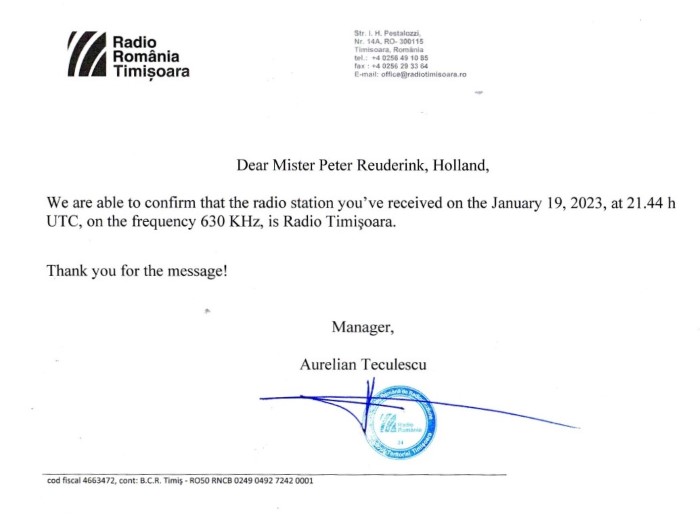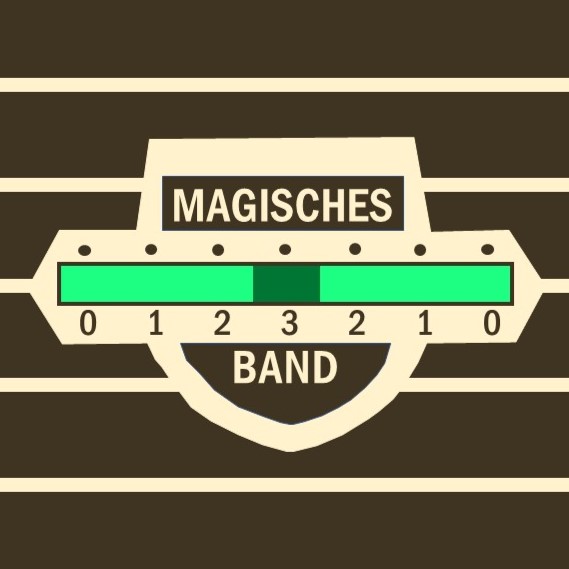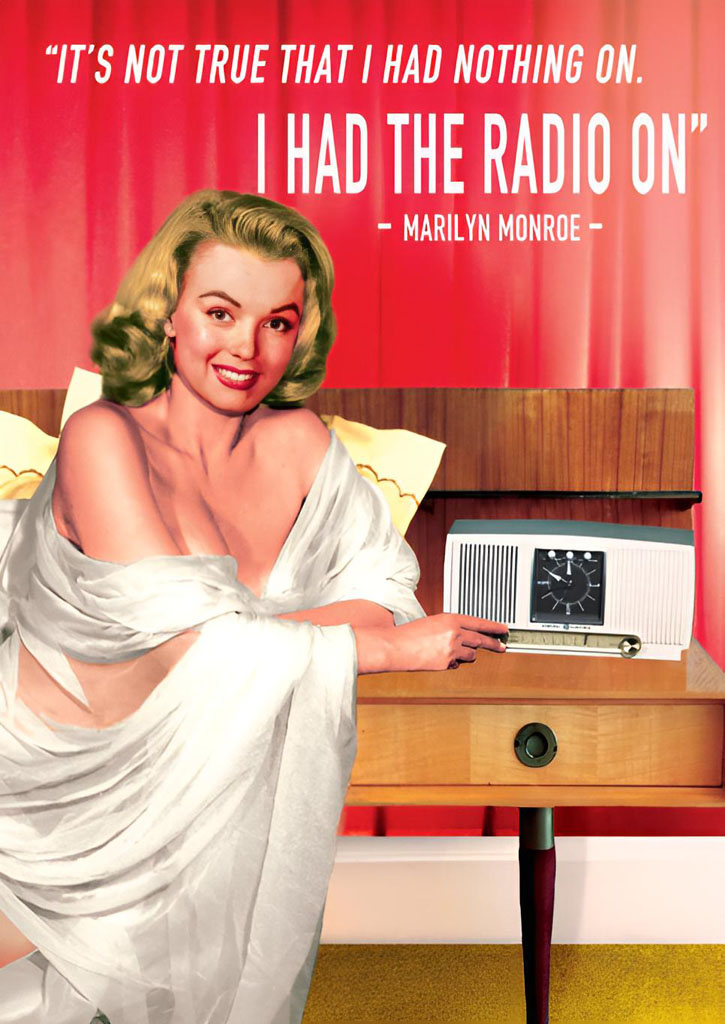
After 50 (!) weeks I received this scanned letter from Radio Timișoara for my reception of their broadcast on 630 kHz. The email was sent by Dana Florea, “Redactor” and “Marketing-Publicate”. Attached were some nice photo’s of Timișoara as well. Email address: office@radiotimisoara.ro
For more information about this station please check my post on the Radio Timișoara QSL I received via the English desk of Radio Romania International a few weeks ago.



A tidy new year, with all the old year’s obligations served.
:))
My thoughts exactly!
Nice QSL! In September 2015 I visited Radio Timisoara and met with its Director. I wrote the following article for DX Fanzine no. 25 of September 2015. Perhaps it could still be of some interest.
RADIO TIMISOARA A POWERFUL “MEDIUM” THAT SPEAKS TEN LANGUAGES
by Antonello Napolitano
During the first week of September I visited the city of Timisoara (in the west part of Romania), the cradle of 1989 anticommunist revolution and today candidate for the European capital of Culture 2021. I took that occasion to stop by at Radio Timisoara. I was greeted by its director Mr. Mihai Anghel, a true gentleman who speaks five languages. Although his Italian was not fluent, due to the presence of my wife who doesn’t understand any foreign language, He insisted that we speak my mother tongue rather than English. Two interesting facts emerged: unlike, for example in France where all AM frequencies will be shutdown at the end of September, Radio Timisoara still relies on its medium wave outlet and that broadcasts are made in ten different languages, including
Italian!
As is well known the number of broadcasters which have ceased transmissions on medium waves has increased significantly over the last years. This led most to assume that medium wave band has no future. But in some parts of Europe there are some who still rely on AM to reach their listeners. “The frequency of 630 kHz is important to us because it guarantees a large audience” says Mihai Anghel, manager of Radio Timisoara, one of the nine regional stations of country’s public broadcasting organization Radio Romania.
The station studios are located in Timisoara and housed in a three-storey building which, prior to 1989 Romanian revolution, was used as a guest house for students of adjacent Communist Party’s school. In the same building is housed TVR Timisoara which however is a separate organization. There is also an additional studio in the city of Arad. Radio Timisoara is primarily funded through public television license fees as well as advertising. All of studios, except for one which dates back to 1990, are digitalized.
Timisoara, capital city of Timi County, and the main social, economic and cultural centre in western Romania, is considered the informal capital city of the historical region of Banat which is currently divided among three countries: Romania, Serbia and Hungary.
The Banat is populated by ethnic Romanians, Serbs, Hungarians, Romani, Germans, Ukrainians, Slovaks, Bulgarians, Czechs, Croats, Jews and other ethnicities. That’s explains why a regional station like Radio Timisoara broadcasts in ten languages (only two less than Radio Romania International!): Romanian, Serbian, Hungarian, German, Romi (the language spoken by Romani people or Gypsies), Czech, Slovak, Ukrainian, Bulgarian and, what a surprise, Italian, a language which, historically, has never been spoken in the Banat region.
Asked why they broadcast in Italian Mr. Mihail replies: “We have many Italian friends. The Italian community is very large. About 18000 Italians are here for work reasons”.
It should be mentioned that there is a large presence of Italian investors in Romania, but most of them are found in the west part of the country and especially in Timisoara which in 2007 counted 420 Italian companies registered with a capital of more than 2 million Euro.
Called “Spazio Italia”, the Italian programme of Radio Timisoara can be heard on the first Monday of each month from 19.00 to 20.00 (local time) on the VHF-FM frequency of 105.90 MHz or from streaming audio on their website (www.radiotimisoara.ro). It consists of current affairs, art, culture, recipes and of course Italian songs.
The first edition of “Spazio Italia” was aired in June 2007. ”Carlo Marchegiano, an Italian investor living in Timisoara, and his wife Margherita Lenzini, were the initiators of the programme”, says Mr. Mihai Anghel. “There are three or four more Italians involved as well as a colleague of Radio Timisoara who assembles the transmission”.
A typical broadcast day includes news, current affairs, culture, sport and different kinds of music, including pop and rock. The station also plays from 08.00 to 09.00, on 630 kHz only, a show of Romania’s folk music accompanied by listener’s dedications.
Daily programmes are in Romanian, German (13.00-14.00 only on MW ), Hungarian (14.00-15.00 only on MW) and Serbian (15.00-16.00 only on MW). Similar to Italian, broadcasts in the remaining six foreign languages are not transmitted daily.
Radio Timisoara in addition to its 630 kHz medium wave frequency has three FM transmitters at Timisoara (105.90 MHz), Arad (102.90 MHz) and on Mount Coseviza (103.60 MHz). According to Mr. Anghel, the same programmes are carried on both FM and AM bands in the following time blocks: 00.00 to 08.00, 11.00 to 13.00 and 16.00 to
18.00.
Not all FM transmitters broadcast the same content simultaneously. For example, from 19.00 to 22.00, on 102.90 MHz and 103.60 MHz, there is a separate programme which is produced in the studio located in Arad. In the same time block, a repeat of German (19.00-20.00), Hungarian (20.00-21.00) and Serbian (21.00-22.00) morning broadcasts is aired over the 105.90 MHz FM transmitter located in Timisoara.
According to Mr. Mihai Anghel, a 400 Kw transmitter located at Ortisoara, about 25 Kms from Timisoara, is used for broadcasting on 630 kHz . The station has been heard in most parts of Europe, including Finland. “We received many reception reports from listeners who are amateurs radio enthusiasts”, says Mihai Angel. Do you verify reception reports? “Yes, our chief engineer acknowledges reception reports by E-mail but in the past we
used to reply by snail-mail”.
Sport is very important for listeners of Radio Timisoara. The manager of Radio Timisoara explains that in the city there are two football teams: ACS Poli, which plays in the first division and, despite it plays in Liga III (the third level of the Romanian football league system), the most loved Politehnica Timisoara. “Videos of this team (Politehnica) on our website – comments Mr. Mihai Anghel – are among the most viewed by its Romanian fans
living abroad”.
Among the other activities of Radio Timisoara are sponsorship of traditional folk music festivals and production of CDs containing traditional, folk, fanfare and classical music performed not only by school or amateur orchestras, choirs or brass bands but also by well-known composers like György Kurtág. His composition “Colinda Balada” was released on CD by Radio Timisoara and was first performed in 2009 Romania. Kurtág, who is Hungarian, wrote it for his birthplace, Lugos and it was also a tribute to the Romanian language he learnt when he was young.
The day of my visit to the station coincided with the “Iosif-Sivu si Cosmin Golban” International Folk Festival’s final night which was presented by Daniela Bacila, a nice music editor of Radio Timisoara. Mr. Mihai Anghel was also there to deliver a metal plaque to the winner of a 400 RON (approx 90.00 Euro) Radio Timisoara prize.
Speaking of future plans Mihai Anghel says: ”We hope to have more frequencies for covering our region. Our broadcasts attract lots of listeners, 250,000 per day, but there is a big difference between AM and FM which is not able to cover all of our region. With the introduction of DRM that difference will be bigger as listeners don’t have receivers able to pick up digital broadcasts. For that reason AM remains fundamental for us”.
Antonello Napolitano.
Apologies for the late reply Antonello, but I have been quite busy last week with the CLE299. Thank you so much for the additions to my post, much appreciated!